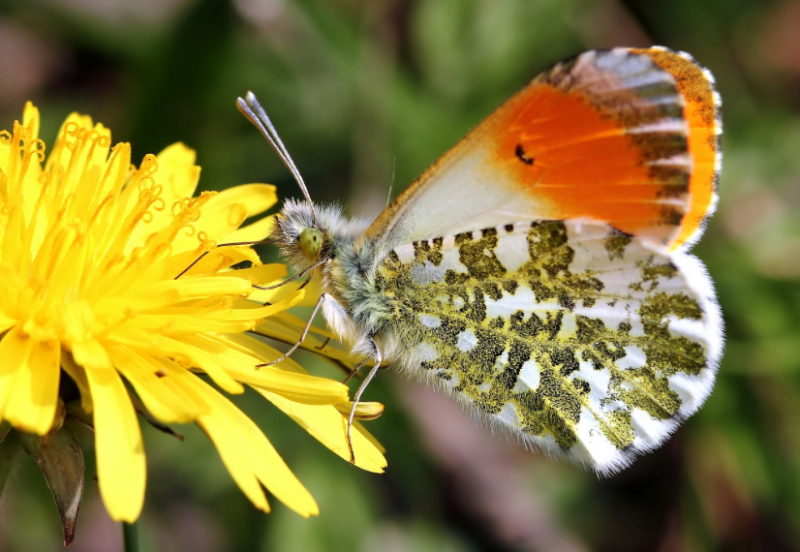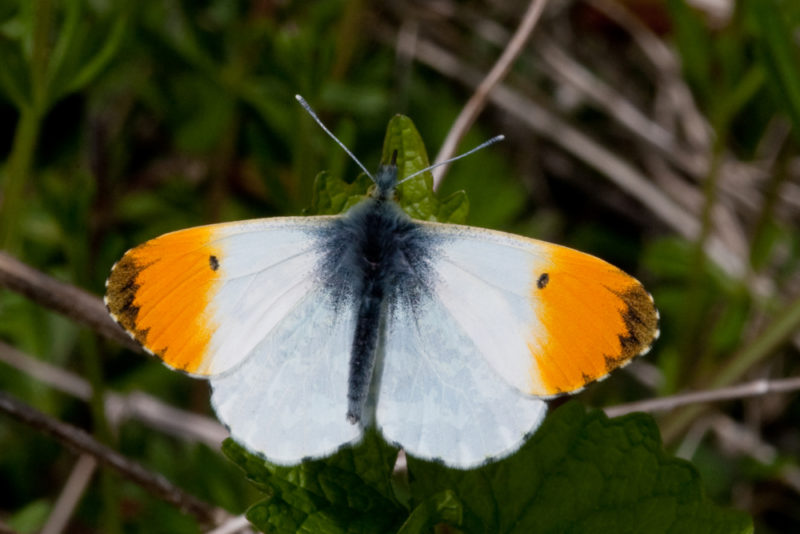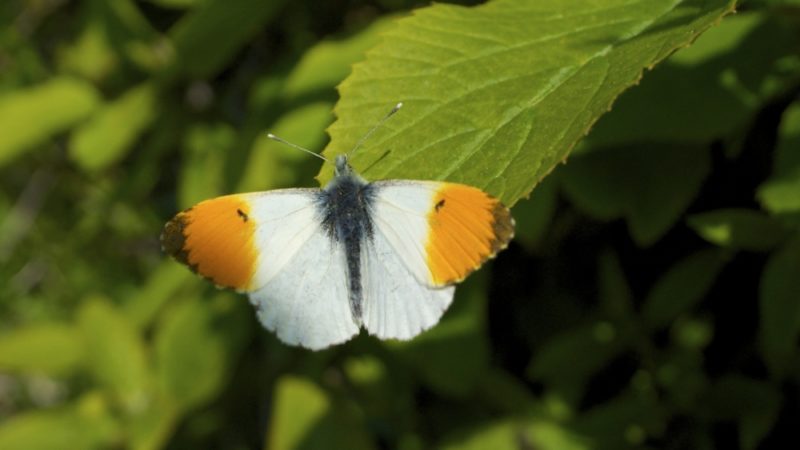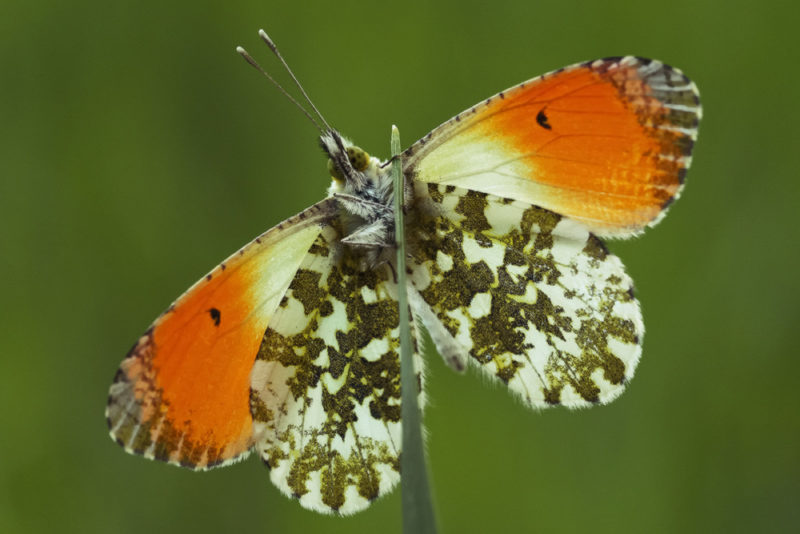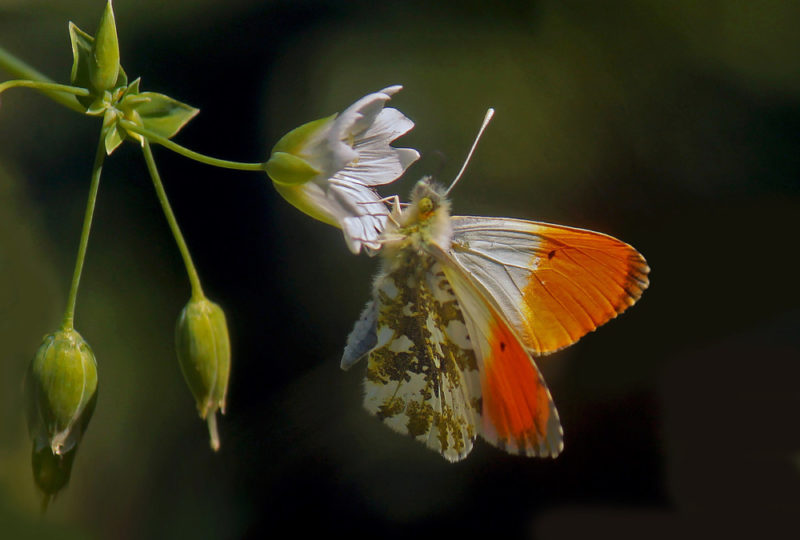The scientific name of the moth in Latin means "dawn." In Russia, this insect is known as the dawn butterfly. The presence of bright color refers to males, females look more modest.
Material Content:
Description and features of the butterfly dawn
In the appearance of the Aurora there are many typical signs of insects of the Belyanok family. The Latin name of the species contains the term Cardamine - this is the grass core, the main host plant for the larvae.
What does a dawn butterfly look like?
We offer a brief description of the form:
- oral apparatus in the form of a proboscis;
- body length - about 1.8 cm;
- wingspan - from 4 to 5 cm;
- on bright orange spots at the outer edge of the male front wings there are black dots that are clearly visible in a large photo;
- the hind wings of both sexes are round with a dark olive marble pattern on the lower surface;
- when the aurora butterfly folds its wings, it becomes invisible on plants thanks to a masking pattern.
In the color of adults, sexual dimorphism is manifested. The main color of the wings is white. Males Anthocharis cardamines have clearly visible bright orange “triangles” on their front wings. The head and chest are covered with yellow-gray hairs.
Aurora in ancient Roman mythology is the goddess of the Morning Dawn, the sister of the sun god, giving people light at the beginning of the day.
Females are discreetly colored. Females from afar seem monotonous. The wings are light gray or whitish with a dark border around the edge. On the head and chest, pubescence of dark gray hairs.
The caterpillar is small, light blue-green or gray-green. There are black dots along the sides. The head is green. The legs are equipped with claws to help keep the body on the feed plant.
Habitat and habitat
The species is distributed over a large part of Eurasia - from the British Isles to Of Japan. The northern boundary of the range is at the latitude of the Arctic Circle. To the south, butterflies extend to the desert zone. Adult insects can be seen in the mountains to an altitude of 2000 m above sea level.
In the southern part of the range, the dawn flies from the end of March to June, in the northern latitudes and at high altitudes - from the middle or end of April almost all summer.
The day butterfly prefers motley meadows (dry and wet), slopes of beams, light forest edges, roads and clearings. Dawns live in city parks, squares, fly in gardens, hedges.
Butterflies choose well-lit areas on the border of tree stands and grassy vegetation. Males can fly in search of females far along the floodplain of the river, the railway embankment.
What does an insect eat?
Butterflies suck out nectar of flowers with the help of a proboscis. Adults prefer flowers of dog violets, primrose, inflorescences of oregano, evening supper, and snakehead. Caterpillars feed on young leaves.
Fodder for the larvae are wild species of the Cabbage family. Most often, caterpillars feed on the core of meadow and other species of the genus Cardamine. Larvae can be found on the garlic, colza, shepherd’s bag, yarut, gallows, and resident.
Reproduction and longevity
The mating ritual includes persistent courtship of males for partners flying and resting on plants. After mating, the female begins egg laying, choosing for attachment of eggs the inflorescences and peduncles of the host plants.
Larvae develop about 5-12 days, mainly from late May to mid July. Caterpillars eat flowers, ovaries and young seeds in the pods of cruciferous plants. Shedding occurs 4 times in about 5 weeks.
Caterpillars of the last generation in July descend down the stalk, are fixed with a secreted silk thread and pupate. The pupa is spiky in shape, green in color, later darkens and turns brown. It is hardly noticeable on the stems of plants, resembles a dry thorn or pod in shape. At this stage, the aurora hibernates. Adults appear after 10 months.
Interesting Facts
Orange spots signal insectivorous birds and other dawning enemies that the butterfly is poisonous. A female who does not have a bright warning color behaves more secretively, is hardly noticeable in the forbs.
In the body of the Aurora, even at the stage of the larva, a substance accumulates that irritates the mucous membranes of the respiratory and digestive organs of the enemies.
During masonry, the female secretes pheromone to the plant's organs to warn other female individuals that the flower is busy. Rivalry is manifested at other stages of development. A strong caterpillar can eat a weak larva if they compete on the same fodder plant.
Species protection
Aurora is listed in the Red Book of several countries, as well as individual regions of Russia. Butterflies feed mainly on grass meadows, the area of which is constantly decreasing. Pupae survive only where plants remain for the winter, are not destroyed.
Widespread mowing and burning of grass are the main reasons for the reduction in the number of species in the boundaries of settlements, in meadows and forest edges. Mosaic mowing, sowing grass seeds in areas free from economic activity will help preserve the living decoration of meadows and fields.


